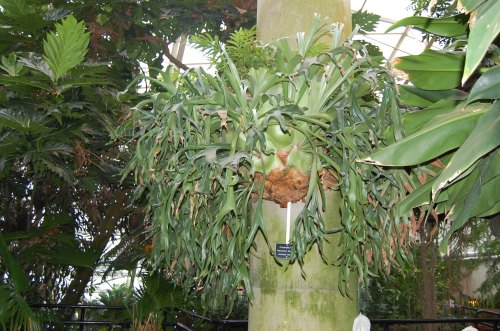While I was at home in Fort Wayne, Indiana, visiting my family for the holidays, I visited with Andy Force, the Supervisor of Horticulture for the Foellinger-Freimann Botanical Conservatory. The conservatory consists of three indoor gardens and showcases over 500 species of plants and 72 types of cacti. A Jaboticaba tree, native to South Brazil, is one of the oldest plants in the conservatory, and has been growing since the gardens opened in 1983.
Andy has been working with the conservatory since 1989, when this Staghorn fern was roughly the size of a basketball.

Staghorn Fern
Back in those days, the pest control was accomplished with chemicals, and once a week they would bring in the machines and spray everything. Andy noticed that spraying did help to reduce the pest populations, but only temporarily. In 1991 he started using beneficial insects, and has been fine-tuning his program ever since. “One of the great things about the beneficial insects, that I keep telling people, is that the beneficial insects usually find the problems that we have before we know we have them. We’ve come out here and seen there are mealybugs here and we looked at it and found Cryptolaemus already on the plant working on it. So a lot of the time we don’t need to do anything except watch.”
Andy notices that the south side of the rooms in the conservatory get the most pest problems, and it is there that he does the most releases of beneficial insects. “The bananas, normally mealybugs like, but they tend to leave them alone. I bet if they were on that [the south] side of the house, they would get more mealybugs.” Since Andy has been working with an IPM program since 1991, he has an excellent handle on what pest problems his plants get, as well as when to expect them. The Ficus tree gets a lot of thrips, for which he periodically releases Atheta coriaria, Amblyseius cucumeris, and Orius insidiosus. Also, Andy has seen that the thrips are attracted to the light coming in through the exit door so he’ll open the door and shoo the thrips outside, as another control strategy. The Butterfly Palm frequently gets a scale infestation, and receives many of the Lindorus lopanthae beetles sent to the conservatory. Andy uses the Encarsia formosa cards on the Hibiscus to help combat the whitefly problems, and in the spring, the cacti bloom and typically get spider mites, which he controls with releases of the predatory mite, Phytoseiulus persimilis.

This Jaboticaba tree has been growing in the conservatory since 1983. As the tree matures, the bark peels and takes on a look similar to camouflage.
In my opinion, Andy exemplifies how one should approach biological control. He is very familiar with the plants in the collection and the typical challenges that are associated with each. Not only is he observant of the pests and natural enemies that help control them, but he is also patient with the level of control that is achieved naturally. Andy understands that biological control is not total eradication of a pest problem, but rather, suppression of a pest to a level such that the pest is in balance with the natural enemies present, and that the damage is not devastating to the plant. Further, Andy embraces the idea that for biological control to be effective releases need to be proactive, not reactive. Every year before spring, Andy sets up advance orders to ship monthly for the duration of the year. Andy knows when to expect certain pests, and releases the beneficials in anticipation of these outbreaks, which allows the beneficial insects to establish themselves in the conservatory and seek out the pest problems, often even before they are apparent.
Stay tuned to learn about the Foellinger-Freimann Botanical Conservatory’s involvement with CITES and the exciting story that Andy Force shared with me about illegally smuggled orchids.



